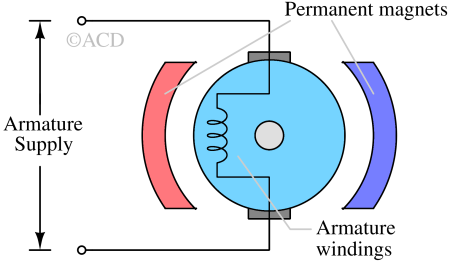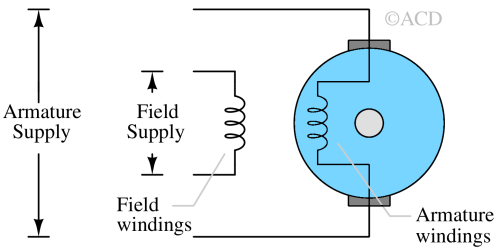Types of DC motor¶
DC motors vary based on the arrangement of connections between the field winding and the armature, with options for parallel, series, or both. Another key distinction lies in how the rotor receives power, either through brushes, where current is supplied via brushes, or brushless motors, where the rotor features a permanent magnet. These motors are extensively used across diverse applications, each type tailored to specific needs. Understanding these variations is crucial, given their ubiquitous presence in various facets of everyday life.
Brushed DC motors¶
A brush DC motor generates a magnetic field in the armature coil (rotor) via current passing through a commutator and brushes. The magnetic field in the stator is produced by either permanent magnets or field windings. The armature windings can be self-excited or separately excited with the field windings. In self-excited DC motors, armature coils (or rotor coils) can form series or parallel windings with field windings, creating either series or shunt-wound DC motors. Self-excited motors include shunt, series, and compound variations, further divided into cumulative and differential types with short and long shunts.
Permanent magnet DC motor¶
A permanent magnet DC motor features an armature winding but lacks a separate field winding. The permanent magnets are situated on the stator's inner surface, generating the motor's magnetic field. It includes a standard armature equipped with a commutator and brushes. These DC motors are smaller, more cost-effective, and utilize rare earth magnets like samarium cobalt or neodymium iron boron.

Separately excited DC motor¶
In a separately excited DC motor, the armature winding and field winding receive power from separate electrical sources. These windings operate independently without affecting each other's functions, although their combined input power constitutes the total power supplied to the motor.

Self excited DC motor¶
Self-excited DC motors feature interconnected field and armature windings, drawing power from a single supply source. Self-excited DC motors can be categorized in the following ways:
- Shunt excited motor.
- Series excited motor.
- Compound excited wound.
Shunt excited Motor¶
A shunt wound DC motor has its field and armature windings linked in parallel, allowing the field winding and armature winding to have identical terminal voltage. The currents in the field and armature windings differ. The speed of a shunt DC motor remains constant and unaffected by changes in mechanical loads.

Series excited Motor¶
The field and armature windings of a series DC motor are linked to the power supply in a series configuration, allowing the same current to flow through both windings. This type of motor, termed as a series wound motor, can operate with both AC and DC voltage supplies, rendering it a universal motor. Series motors consistently rotate in a single direction, irrespective of the voltage source. However, their speed fluctuates in response to changes in mechanical load.

Compound excited motor¶
A compound DC motor combines elements of both series and shunt field windings, featuring a series-connected armature winding and a shunt or parallel-connected field winding.
Based on where the shunt winding is placed with respect to the series windings, compound DC motors are categorized as :
- Short shunt DC motor
- Long Shunt DC motor
Based on how the magnetic flux interacts, compound DC motors are categorized as :
- Cumulative compound motor
- Differential compound motor

Short shunt DC motor¶
If the shunt field winding runs solely in parallel with the armature winding and doesn't include the series field winding, it is referred to as a short shunt DC motor, or more precisely, a short shunt type compound wound DC motor.
Long shunt DC motor¶
If the shunt field winding is in parallel with both the armature winding and the series field winding, it is termed a long shunt type compounded wound DC motor, or simply a long shunt DC motor.
Cumulative Compound DC motor¶
A compound wound DC motor is considered cumulatively compounded when the shunt field flux generated by its winding supports or amplifies the influence of the primary field flux created by the series winding.
$$phi{}_{total}=phi{}_{series}+phi{}_{shunt}$$
Differential Compound DC motor¶
When the shunt and series windings are configured in a way that the field flux produced by the shunt field winding reduces the impact of the flux generated by the main series field winding, it is termed a Differential compound DC motor. Both variations of compound DC motors, whether differential or cumulative, can be classified as either short or long shunt types based on their arrangement.
$$phi{}_{total}=phi{}_{series}-phi{}_{shunt}$$
Brushless DC motor¶
Brushless DC motors (BLDC) are electric motors driven by direct current and controlled electronically. They use permanent magnets and an electronically controlled system to produce rotational torque by changing phase currents. Unlike brushed DC motors, which rely on mechanical contact, BLDC motors feature a rotor with magnets and a stationary stator with coils. The armature coils are switched electronically by transistors based on the rotor's position sensed by Hall sensors. This design eliminates the need for brushes, making BLDC motors more reliable, quieter, and more efficient, with efficiency ratings typically ranging from 85% to 90%. The absence of brushes reduces wear and tear, as minimal heat is produced by the rotating magnet. More details on this page - Brushless DC motor.